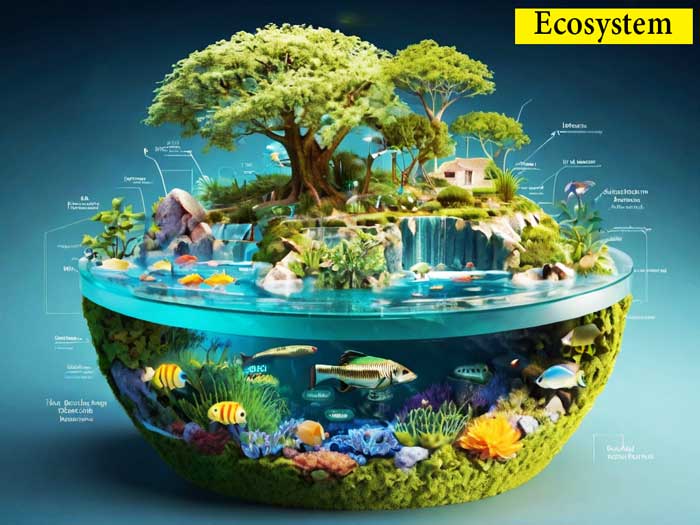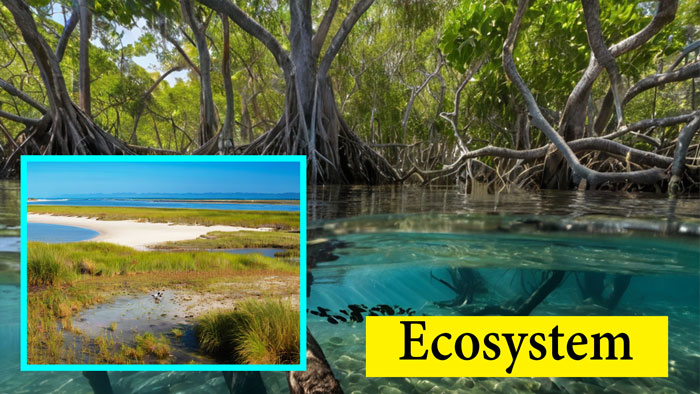Exploring the Vital Role of Ecosystems in Sustaining Life on Earth: A Comprehensive Guide
The ecosystem is a self-regulatory and self-sustaining structural and functional unit of landscape (biosphere) consisting of a community of living beings and the physical environment, both interacting and exchanging materials between them. A.G. Tansley (1935) coined the term ecosystem. Ecosystem Class 12 short notes and revision notes are on the bottom.The man-made ecosystem is the one that is created and maintained by human beings, e.g., agriculture, garden, aquarium, spacecraft. Agriculture or agroecosystem is the largest man-made ecosystem.
STRUCTURE OF ECOSYSTEM
The interaction of biotic and abiotic components results in the physical structures that are characteristic for each type of ecosystem. These are:
(i) Species composition: Identification and enumeration of plant and animal species of an ecosystem give its species composition. Maximum species composition occurs in tropical rainforest and coral reefs.

(ii) Stratification: It is the formation of vertical layers where vegetation is dense, e.g., 5 – 7 strata in tropical rain forests. Stratification is absent or rare in deserts.
(iii) Trophic structure: Trophic structure of an ecosystem is a type of producer-consumer arrangement, in which each food level is called trophic level. Each ecosystem has specific food chains and food webs, e.g., grazing food chain in grassland.
(iv) Standing crop: It is the amount of living biomass present in a unit area of an ecosystem.
(v) Standing state: It is the number of inorganic nutrients present at any time in the soil/water of the ecosystem. It tends to vary from season to season and ecosystem to ecosystem.
FUNCTIONS OF ECOSYSTEM
Four important functional aspects of the ecosystem are productivity, decomposition, energy flow and nutrient cycling.
Productivity
(i) Productivity: It refers to the rate of biomass production by any trophic level per unit area in unit time. It is measured as weight (e.g., g/m2/yr) or energy (e.g., kcal/m2/yr). It is of following types:
Primary productivity: It is the amount of biomass or organic matter produced per unit area over a time period by plants during photosynthesis. It is further divided into gross primary productivity and net primary productivity.
The rate of production of total organic matter by green plants by photosynthesis per unit area per unit time is known as gross primary productivity (GPP). A considerable amount of GPP is utilized by plants in respiration (R). The energy left after respiration and stored as organic matter in the producers per unit time and area is called net primary productivity (NPP).
NPP = GPP – R
Secondary productivity refers to the rate of assimilation of the organic matter at the level of consumers. It is the amount of energy available at the consumer level for transfer to the next trophic level.
Decomposition
(ii) Decomposition: It is the physical and chemical breakdown of complex organic remains (detritus) with the help of organisms called decomposers. The processes involved are fragmentation, catabolism and leaching.
Detrivores (e.g., termites, earthworms) feed on large pieces, and smaller fragments are left. Pulverisation occur in the digestive tract of animals as a part of it comes out undigested. The process is called fragmentation. The decomposers (e.g., bacteria, fungi) excrete digestive enzymes over the detritus.
It changes insoluble complex organic substances into simple and soluble organic compounds and inorganic substances (catabolism). Soluble substances formed during decomposition are subjected to leaching or passage to deeper layers of soil/groundwater by percolating water.
Humification leads to the formation of a dark-colored amorphous substance called humus, rich in cellulose and lignin. It is highly resistant to microbial action and undergoes decomposition at an extremely slow rate. Humus is further degraded by some microbes and release of inorganic nutrients occurs by the process of mineralisation.
Decomposition is dependent on oxygen availability. It also depends on the chemical composition of detritus and climatic conditions. Decomposition is faster when detritus is rich in nitrogen and sugars than when detritus is rich in lignin and chitin. Warm and moist environment favours decomposition.
Energy flow
(iii) Energy flow: Sun is the ultimate source of energy in all ecosystems.
Of the incident solar radiation, less than 50 per cent of it is photosynthetically active radiation (PAR). Plants and photosynthetic and chemosynthetic bacteria (autotrophs), fix sun’s radiant energy to make food from simple inorganic materials. Plants capture only 2-10 per cent of the PAR and this small amount of energy sustains the entire living world.
The flow of energy takes place from producers to different consumers in an ecosystem which constitutes different trophic levels.
Food Chain
A food chain involves a nutritive interaction between the living organisms (biotic components) of an ecosystem. Here occurs repeated eating i.e., each group eats the other and is subsequently eaten by some other group of organisms. The number of steps in a food chain is limited to four or five and at each step, a large portion of the energy is lost as heat. In a food chain, there is a unidirectional flow of energy. There is a transfer of 10% energy from one trophic level to another. This is called 10% law formulated by Lindemann in 1942.
Food web is a network of food chains which become interconnected at various trophic levels so as to form a number of feeding connections amongst the different organisms of a biotic community.
An ecological pyramid is a graphical representation of ecological parameters like biomass, energy and number of individuals present in the various trophic levels of a food chain with producers forming the base and top carnivores the tip. Ecological pyramids were developed by Charles Elton (1927) and are therefore also known as Eltonian pyramids.
Calculations of energy content, biomass, or numbers have to include all organisms at that trophic level. No generalizations will be true if few individuals are considered at any trophic level into account.
A given species may occupy more than one trophic level in the same ecosystem at the same time; for example, sparrow is a primary consumer when it eats seeds, fruits peas, and a secondary consumer when it eats insects and worms.
There are certain limitations of ecological pyramids such as it does not take into account the same species belonging to two or more trophic levels. It assumes a simple food chain, something that almost never exists in nature, it does not accommodate a food web. Moreover, saprophytes are not given any place in ecological pyramids even though they play a vital role in the ecosystem.
(iv) Nutrient cycling: Biogeochemical cycles or nutrient cycles are cyclic exchanges, transfer, and storage of biogenetic nutrients through various components of the ecosystem (biotic and abiotic), so that the nutrients can be used repeatedly again and again. The reservoir pool and cycling pool are two stores of nutrients. The reservoir pool is the reservoir of biogenetic nutrients from which the nutrients are transferred to the cycling pool.
ECOLOGICAL SUCCESSION
Ecological succession is the observed process of changes in the species structure of an ecological community over time. The first group of organisms establishing during an ecological succession are known as the pioneers, primary community or primary colonisers. Climax community is the stable, self-perpetuating and final biotic community that develops at the end of biotic succession and is in perfect harmony with the physical environment. Climax community has maximum diversity and niche specialization. The various biotic communities that develop during biotic succession are termed as seral or transitional communities.
Primary succession starts from the primitive substratum, on a previously sterile or primarily bare area. Secondary succession starts from previously built up substrata with already existing living matter. In secondary succession since the soil is already there, the rate of succession is much faster and hence, the climax is also reached more quickly.
Hydrosere (hydrarch) refers to the biotic succession in a newly formed pond or lake. The stages that occur in hydrosere are Plankton stage, rooted submerged stage, rooted floating stage, free-floating stage, reed swamp stage, sedge or marsh meadow stage, woodland stage, climax forest stage.
Xerosere (xerarch) refers to the succession that occurs at places where moisture is present in minimal amounts such as dry deserts, rocks, etc. _e stages that occur in xerosere are: crustose lichen stage, foliose lichen stage, moss stage, herb stage, shrub stage, forest stage.
Ecosystem Services
Healthy ecosystems are the base for a wide range of economic, environmental and aesthetic goods and services. The products of ecosystem processes are thus named as ecosystem services, for example, healthy forest ecosystems purify air and water, mitigate droughts and floods, recycle nutrients, generate fertile soils, provide habitat to wildlife, maintain biodiversity, pollinate crops, provide storage site for carbon and also provide aesthetic, cultural and spiritual values.
